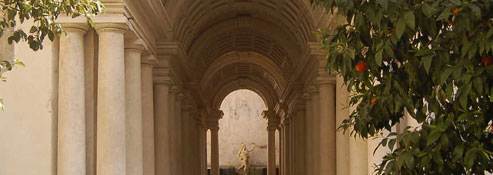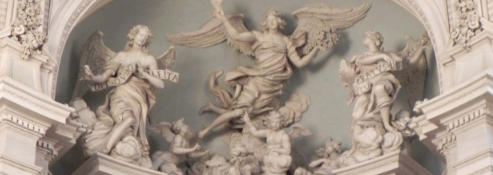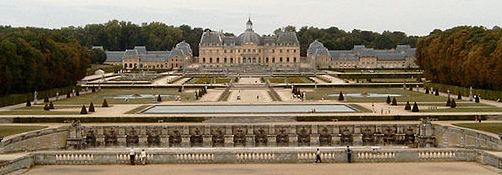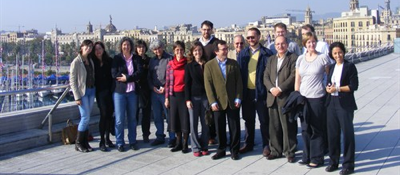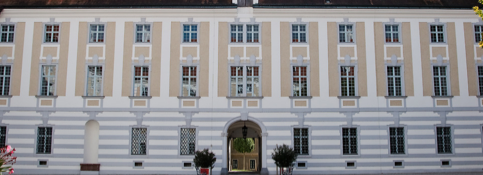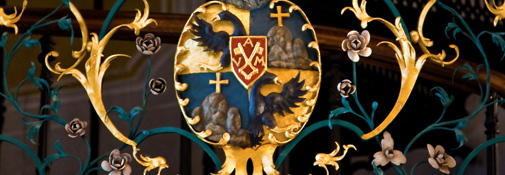From the 1720s until her death in 1735 she was one of the best-known, most admired and most intriguing women in Rome. She arrived in the city in June 1719, a young and hopeful girl coming to marry James III Stuart, the Old Pretender to the British throne. A combination of beauty, charm, impeccable manners and good education quickly made her the darling of Rome's aristocracy and church officials, including Pope Clement XI: "Les premières Princesses de Rome l'ont été visiter, et chacun dit que l'on n'a jamais veu une personne avoir tant de jugement et d'esprit qu'en a cette jeune Princesse, qui charme tous ceux qui ont l'honneur de lui parler". [1] On her deathbed in 1735 - profoundly religious and obsessed with death, emaciated from ascetic practice and an austere lifestyle - she was widely considered a saint, and continued to be remembered long after her death. [2]
In this paper I talk about Maria Clementina Sobieska Stuart, whose life seems to offer a symbolic reflection of the Baroque soul with its love of extremes and sharp contrasts. Clementina loved beautiful things, sophisticated jewellery, and simple pleasures of life. She was a great lover of music, and during her early years, which she spent in Rome, she patronized opera and musicians. Her final years were dominated by mysticism and filled with silence, whispered prayers and masses attended in Rome's churches. Very soon after her arrival in Rome a piece of music (a birthday cantata) was dedicated to Maria Clementina in July 1719. The text is intentionally political, but many of the poetic passages are also remarkably sensual. I want to show how this early work, which forms the focal point of my paper, would become a potent symbol for Maria Clementina's life.
Maria Clementina Sobieska Stuart
Maria Clementina Sobieska was born in 1701 in the Italian town of Macerata. She was the daughter of Prince Jakub Sobieski, eldest son of Maria Casimire Sobieska and King Jan III Sobieski of Poland, and Countess Palatine Hedwig Elisabeth von Neuburg. [3] On her mother's side she was related to many of Europe's ruling families, and Pope Clement XI was Clementina's godfather. In 1718, James III Stuart, a pretender to the British throne, asked Charles Wogan, a trusted courtier touring European courts in search of a suitable wife for the Old Pretender, to sound out the young Clementina as a marriage prospect. During the carnival of 1718, Wogan came to Oława, a town in Silesia that belonged to the Sobieski family. Of all the princesses Wogan had met on his tour, Clementina made the best impression. A lengthy period of complex negotiations ensued, rife with intrigue and espionage, before a marriage contract was finally signed. In the autumn of 1718 the young Sobieska left for Italy in the company of her mother and a small retinue, travelling to join her future husband. Threatened by the pretender's marital plans, King George I, the ruling Hanoverian king of Britain, put political pressure on Emperor Charles VI to imprison Clementina on the way, and she was confined in Innsbruck Castle. This act sent waves of shock and indignation throughout Europe, but the Emperor ignored appeals to release the young princess. [4] In response, Wogan orchestrated a daring and well-organised escape, a plan which proved successful thanks to the assistance of several loyal persons. Clementina's daring escape became the talk of Europe; laudatory verse was written in honour of the brave princess, comparing her to her illustrious grandfather, King Jan III of Poland; accounts of her escape were printed, and numerous medals were minted bearing Clementina's likeness. [5]
Not long after Sobieska's arrival in Bologna, a marriage ceremony was performed by proxy on 9 May 1719, followed shortly by Maria Clementina's arrival in Rome. She was given a truly royal welcome [6] and moved into a specially prepared apartment in an Ursuline monastery, there to await James on his way back from an expedition to Spain. She spent the following days entertaining visitors, including church officials and Rome's aristocratic ladies, and enjoying the sights of Rome, where she was always surrounded by large retinue and fêted like a true queen: "[…] ella si portò a visitare il Campidoglio, dove fù ricevuta col suono delle Trombe, e de'tamburi, e con tutti gli onori, che si praticano alle Teste Coronate. Il medesimo è stato praticato, quando ella è stata a visitare accompagnata dal Cardinal Gualtieri, il Collegio degl'Inglesi, dov'è stata servita come Regina". [7] Charles Poerson, Director of the French Academy in Rome, commented in his writings: "Cette Princesse se fit admirer dans cette occasion, comme elle a fait dans toutes celles où elle s'est trouvée. L'on loue extrêmement son esprit vif et beau, qui se trouve, dit-on, soutenu d'un jugement qui serait admiré dans une personne d'un âge plus avancé" [8], attesting to Clementina's talent for working crowds and making new friends.
On 2 September 1719, the actual marriage ceremony between James and Clementina took place at Montefiascone, a small town near Rome. The newlyweds took residence in the Palazzo del Re at the Piazza SS. Apostoli, provided to them by Pope Clement XI. [9] The marriage ended the first period in Maria Clementina's life.
Maria Clementina and Music
Maria Clementina loved music, and she liked to sing and play music instruments. In the early weeks in Rome, before she moved out of her rooms at the Ursuline monastery, she commissioned a performance of Te Deum in the presence of Cardinal Aquaviva and several other important officials to celebrate James's birthday. [10] As mentioned before, her own birthday, too, was celebrated with a cantata, a subject to which I will return shortly. When their children were born - Charles Stuart (1720) and Henry Stuart (1725) - Clementina passed on her passion for music to her sons. She liked to host concerts from leading artists in her Rome residence. An English gentleman visiting Rome as part of his grand tour gave an enthusiastic account of a private concert to which he was invited by Maria Clementina: "The Princess, who stood by, addressing to the Doctor, in the prettiest English I think I ever heard, said, Pray! Doctor, if these Gentlemen be lovers of Music, invite them to my Consort to-night; I charge you with it: Which she accompanied with a Salute and a Smile, in the most gracious Manner". [11] The gentleman gladly accepted the invitation and went to James and Clementina's palazzo where, as they recounted, "[we] saw a bright Assembly of the prime Roman Nobility, the Consort compos'd of the best Musicians of Rome, a plentiful and orderly Collation served". [12]
Clementina was also a great fan of Rome's feste including carnival balls and entertainments. [13] An issue of "Mercurio storico e politico" dated March 1723 reported: "Il penultimo, e l'ultimo giorno di Carnevale la Nobiltà giovane di questa Città fece una Festa di ballo assai magnifica, accompagnata da una splendidissima Colezione nel Palazzo Pasquino, ch'ella aveva preso a pigione a quest'oggetto. Il Rè, e la Regina d'Inghilterra si trovarono a questa Festa, la quale durò fin'alla mattina del giorno susseguente" [14]; Clementina and her husband also frequently visited Rome's opera theatres. In one of them, Teatro d'Alibert, the couple had three private boxes [15] and were the only party allowed to eat dinner on the premises: "Il Re, e la Regina d'Inghilterra andarono l'altro giorno all'Opera, che fu rappresentata nel Teatro Aliberti, in compagnia col Cardinal Alberoni; e lo trattarono poscia splendidamente a cena nel palchetto del medesimo Teatro, donde avevano veduta la rappresentazione dell'Opera". When a marital crisis pushed Clementina to leave her husband and to live at the monastery of St Cecilia, Baron Philipp von Stosch, who for many years served the British king one of his spies, reported: "Mecredy le 21me la Princesse de Piombino fu diner chez la princesse Sobiesky au Couvent apres quoy elle alla trouver le Pretendent a son Palais pour negotier l'accommodement. Il paroit presentement que le desir de voir l'Opera de Aliberti fait plus d'effet sur l'esprit de la Princesse, que touts les raisonnements fortes du Cardinal Alberoni, qui pretend en vain de semer un heroisme dans l'esprit d'une femme infiniment adonne' aux divertissements et spectacle". [16] Clementina extended patronage to Rome's opera theatres, where she was always a prized guest. [17] At the Teatro d'Alibert (later renamed to Teatro delle Dame), the following pieces were dedicated to Maria Clementina:
- Faramondo, lib. A. Zeno, mus. F. Gasparini, 1720
- Eumene, lib. A. Zeno, mus. N. Porpora, 1721;
- Flavio Anicio Olibrio, lib. A. Zeno, P. Pariati, mus. N. Porpora, 1722;
- Adelaide, lib. A. Salvi, mus. N. Porpora, 1723;
- Scipione, lib. A. Zeno, mus. L. A. Predieri,1724 [18];
- Il Valdemaro, lib. A. Zeno, mus. D. Sarro, 1726;
- Siroe Re di Persia, lib. Metastasio, mus. Porpora, 1727;
- Artaserse, lib. Metastasio, mus. L. Vinci, 1730 (Teatro delle Dame);
As a patron, Maria Clementina had every reason to feel proud. Most of the pieces were composed by Nicola Porpora and Leondardo Vinci, major representatives of the Neapolitan school then gaining popularity in Italy and Europe. The vocalists included celebrated artists such as Carlo Broschi, famous Farinelli, who was one of Porpora's greatest pupils then making his debut in Rome, and the equally admired Gaetano Majorano, better known as Caffarelli.
The birthday cantata
Maria Clementina's birthday cantata was probably written by philosopher and scientist Francesco Bianchini and set to music by D. Giovanni Giorgi Veneziano (the music does not survive). The title page of the cantata contains some important information:
CANTATA/ PER IL GIORNO NATALIZIO/ Della Sacra Reale Maestà Britannica/ DI/ CLEMENTINA/ REGINA D'INGHILTERRA &c./ In cui si allude alla unione delle due stelle, dette benefice,/ che accade in quell dì 17. Luglio 1719. ed all'/Accademia tenuta, e stampata in Roma/ l'anno 1687. dalla Maestà della fu/ Regina CHRISTINA DI SVEZIA. /In occasione della solenne Ambasciata, spedita alla S. Sede/ nell'assunzione al Trono d'Inghilterra della Maestà/ DEL RE' GIACOMO SECONDO./ Di gloriosa memoria,/ Con riferirsi i sentimenti della célèbre Orazione,/ e le parole de'Versi allora composti/ dalli Accademici Reali/ DEDICATA A SUA MAESTA' BRITANNICA./ Da Monsignore Francesco Bianchini Cameriere d'Onore /di Nostro Signore.
Clementina's birthday was an opportunity to celebrate her union with James, as suggested by the phrase unione delle due beneficie stelle, but also to remind the audiences of the royal past of the Stuart family she was marrying into. This is why the title page mentions the diplomatic mission sent to the Pope by Clementina's late father-in-law, James II Stuart, when he ascendes the British throne. The Pope was not enthusiastic about the Lord Castlemain, the ambassador, who lived in a cloud of scandal, but Christina of Sweden honoured him with a splendid celebration attested in a number of chronicles, a printed account of the ceremony, a published welcome speech for the ambassador, and a printed libretto which contains the information that a cantata by Bernardo Pasquini was performed at the celebration, featuring a 100 person-strong choir and orchestra of 150 instrumentalists under Corelli. [19] The printed edition of the cantata dedicated to Clementina emphasises that passages in italics are taken from Pasquini's work, and those in inverted commas come from the speech.
Gennaro Angelini, a 19th-century Italian scholar, discusses Clementina in an article, where he cites the following passage (without stating the source of this information): "Nel mese di luglio si festeggiò nello stesso monastero di diciassettesimo anniversario della nascita di lei [di Clementina]: nella quel circostanza fu dato un gran pranzo, servito da cavalieri, al quale essa prese parte sotto un baldacchino: inoltre si eseguì una cantata a tre voci composta per questa occasione.". [20]
The cantata has three characters, Genio Celeste, Astrea, and Tevere. It opens with a joyous Coro dell'Ore (Chorus of Hours) which announces the coming of a new day and scatters flowers on the ground ("Spargiamo al suol d'intorno"). Genio Celeste bids welcome to Astrea, goddess of justice, on her visit to the earth, and announces that Hours have foretold the coming of a time of heroes. In her first aria, Caro Giorno, Astrea confirms that a joyous day is coming to bring happiness to the Tiber and the entire world.
Caro giorno,
Che sì adorno
Di letizia in Cielo splendid,
Vieni, e rendi
Col bel raggio tuo giocondo
Lieto il Tebro, e lieto il Mondo. [21]
Given pride of place, the Tiber opens the Capitol to the goddess and asks her in its aria to use her powers and rid the world of hate, suffering, scheming, treachery and war. On this day, says Astrea, we are celebrating the birthday of a famous heroine who has recently turned 15, and has come to Rome to rule over the Britons. This is the goal to which she devotes her years of youth (verdi anni) and to create a new crown, a gift of her devotion and love. The joyous sky scatters flowers and laurels, and Iris (the personification of the rainbow and a messenger of the gods) and the flowers paint the banks and waves of the Tiber in many colours.
The Tiber rather abruptly enquires about a flower it sees: what kind of flower is that, whose light can be compared to the splendour of the heavens, accompanied on its way down from the skies by the ark of Peace? The Tiber had seen imperial eagles and united Portuguese and Spanish troops gathering round this star on the day of her birthday. Now that she is grown, this happy marital union gives her the wreaths of England, Scotland and Ireland.
Vidi ver Lei converse
L'Aquile Auguste, e le congiunte schiere,
E Lusitane, e Ibere,
Di lor bende reali offrir le fasce
Alla Stella, che nasce.
Or, che all'adulta Stella offre ghirlande
Scote, Britanne, Irlande,
Lieto Imeneo, ch'estolle
Del Talamo il fulgor pari alla Cuna,
Dimmi, Cintia, se avrai
L'argento de'tuoi rai,
Se Febo ha l'oro,
Se gemme avran le stele,
Scegliendo le più belle
Al gran lavoro.
Astrea gives an indirect answer. The gods have given her the power to start days with a ray of her choice, she explains, and today she has chosen a Polish heroine, a Royal Maid who shall reign over our hemisphere ("l'Eroina/ Del Polonico suol"). [22]
The Tiber asks Astrea to remind him of a different day, glorious for Rome and the Britons, when joyous cries of victory and calls for new conquests rang in the streets. [23] Astrea points out that the late Queen Christina foretold that the English kingdom would have the new king, and that Genio Celeste would come to the aid of the new king's country. Thus, the cantata author introduces a third character whose aria expresses hope for a new golden age on earth. The Tiber affirms that two favourable stars ("due beneficie stele") have been brought to Rome by Astrea, a most clement goddess ("Clementissima Dea") who has fanned the flame of their sacred love, engendering Peace and Innocence in the world:
Già de'mortali si scordò le offese,
Quando in due cuori accese
Fiamme di santo Amore,
Onde Pace, e Innocenza il Mondo apprenda,
E 'l costume del Ciel la Terra intenda.
In his aria "Dal corso ignobile", Genio Celeste emphasises that faith is necessary to save oneself from the vagaries of fate. Luckily, this couple has a splendid guide, ALBANA STELLA, presumably a reference to Clementina's godfather, Pope Clement XI, born Giovanni Francesco Albani. Significantly, before he became Pope, Giovanni Albani was one of the orators chosen by Christina to make a speech during the memorable celebration for the ambassador. [24] In Clementina's cantata, Genio Celeste cites passages from that speech, reminding the listeners of the story of Abraham and his faithful wife Sarah, who obeyed God's wish and left their native land trusting God's words:
Seguia fedel, e ubbidiente Abramo,
Esule illustre dal paterno suolo,
L'oracolo divin, fatto sua guida.
Seguia scorta sì fida
Esule la Consorte, e un guardo solo
Del Ciel guidava i cor, più che i lor passi.
At one point in the biblical story the Almighty God tells Abraham and Sarah to make a stop on their journey. From the biblical version of this story we know that God promised a great future and numerous offspring to the couple: "in blessing I will bless thee, and in multiplying I will multiply thy seed as the stars of the heaven, and as the sand which is upon the sea shore"; [25] the librettist expresses this idea in poetic terms:
Numera pur se puoi
Gli astri del Cielo.
Tanti ravvisa poi
Fior del tuo stelo.
This is followed by a recitative which also concludes a passage in the above-mentioned speech, "Che de'costanti cuor scrive il portento/ E de'Posteri augusti il firmament". Next, Genio Celeste says that Aurora has spread her mantle, spangled with royal stars. The Tiber adds that Rome, too, is celebrating the birthday of the faithful lovers with similar gold lights. The structure loops back to the opening joyous Chorus of Hours and Astrea's aria "Caro Giorno", followed again by the opening chorus.
Sadly, the couple's life was not as rosy. The early fascination wore off quickly, which was not surprising in a couple so very different in terms of age, life experience, upbringing, and temperament. Unlike Sarah, Clementina was not an obedient, compliant wife: the couple quarrelled over the upbringing of Charles, their eldest son,. [26] and Clementina left James to live in the monastery of St Cecilia in Trastevere. The scandal provoked a very lively interest in Rome, with the public opinion mostly siding with Clementina. The disagreement was also reported in contemporary chronicles and European newspapers. [27] In her monastery Clementina received visits from cardinals and ladies of her acquaintance, and James's letters to Clementina circulated all over Italy. Despite her emotional turmoil Clementina did not turn her thoughts exclusively to prayer, and found time for entertainments: "In tanto la Principessa dice, che sta molto bene nel Monistero di S. Cecilia, le Religiose del quale proccurano di divertirla e si preparono di recitare alla sua presenza una Commedia, nella quale Donna Isabella Aquaviva farà la prima parte". [28] Both spouses remained entrenched in their positions, and the conflict was dragging on. Clementina defended her beliefs and actions in a letter to her father: "I cannot forget that I am your daughter, and a granddaughter of King Jan. If I had done nothing I would have acted against my position and birth, related as I am to so many of Europe's rulers". [29] Obviously, Clementina had a keen sense of her own value. She took pride in her royal descent, and felt confident about her standing in the conflict. Aleksandra Skrzypietz emphasises that Clementina's letters sent to Poland contain no symptoms of a future psychological crisis. [30] However, she spent almost two years separated from her sons, whom she desperately missed, and from her husband, for whom she may also have felt some affection and attachment (or at least a sense of marital duty as understood as the time), and the experience may have gnawed away at her health and resolve. When James announced late in 1726 that he was leaving for Bologna with their sons, "la Principessa ha cominciato a riflettere sopra la lontananza del suo Consorte e de'suoi Figliuoli, è caduta in una malinconia ch'è stata ben presto seguita da uno svenimento, la di cui lunghezza faceva temere di sua vita". [31] Clementina was lifted from her condition by a friend of the Stuarts, Princess di Piombino, and although the family was reunited in 1727, outside observers began to write of Clementina as a person devoted mainly to prayer: a melancholy and lonely presence whose favourite activities included visiting churches and spending time with her sons. [32]
A cache of documents prepared as evidence in Clementina's never-held beatification process (discovered not long ago at the Archivio di Stato in Rome) contains some interesting information and witness accounts relating to Clementina's life in that period. Although the documents are obviously biased, drafted as they were to emphasise Clementina's sanctity in her beatification process, they certainly contain grains of truth. Importantly, the documents reflect a change of heart in Clementina as regards the entertainments that she used to like:
"Ogualm.te la Verità fù, ed é, che scorso qualche anno la Serva di Dio si partò dal Monastero, portarsi in Bologna nel Mese di Luglio 1727, e non avendo ivi ritrovato la Maestà di Rè Suo Consorte, il quale erasi(s) portato altrove, ricusò costante.te qualunque siasi divertimento, riecreazione, e festa, lo pubblica, come privata, che la Città, e l'Emo Buffo Legato preparate avevano, riceverla con quella proprietà, che convenivale, secusandosi? ella con la grazie, e dicendo a quella Nobiltà, che secondo l'insegam.to di S. Paolo, quando il Marito è lontano, la moglie deve star ritirata [emphasis in the original]". [33] James did not ask for this kind of sacrifice, and it would seem that Clementina chose to withdraw from society inspired by the words of St Paul.
Her previous life began to feel empty and meaningless to Clementina, as illustrated in another passage from the beatification documents. She admitted that she used to love beautiful precious jewels. Now she saw her fascination as sinful, and tearfully commented: "Oh mio Dio! Vi ricordate Figlia di quando mi perdevo dietro a' queste pazzie? ed'ancorchè adesso per misericordia di Dio tanto le aborrisca, hò d'aver questo impaccio tra le mani (emphasis in the original). Ed'in ciò dire, con atto di sommo disprezzo legettò via dalle sue mani, piangendo il tempo che prezzate la aveva". [34]
Maria Antonietta Quesada analysed the content and handwriting of the handwritten messages that Maria Clementina sent to her confessor, Fr. Pietro Cangiassi, in 1731-1734. She emphasises the differences between this set of documents and the letters written by Clementina from Innsbruck Castle, where she was imprisoned in 1719. [35] Unlike the round, clearly legible handwriting of her teenage years, the late messages are difficult to read, with shaky letters and a ductus indicative of exhaustion, nervousness and agitation. The content of the late messages is likewise dramatic - Clementina is constantly seeking approval from her confessor, she trusts herself to God and longs for relief in death, and mentions the pitifully small portions of food and drink consumes (a cup of coffee, a sip of broth). The messages suggests that Clementina had retained her gentleness and sweetness but was deeply unhappy and exhausted. She also constantly castigated herself as a sinner unworthy of God's love, given to, in Quesada's apt phrase, "l'accettazione delle sofferenze fisiche come un tributo alla fede". [36] Her greatest pleasure in the closing months of her life was to visit churches: "L'andare in chiesa mi è d'un grandissimo giovamento. Io non sto mai meglio di quando vado in chiesa: Non lo vogliono credere nè il P. Confessore, nè gli alori; e pure ell'è cosi: Jo ne sento grandissimo giovamento". [37] Her dream was to die in a church: "Beata me se potessi morire in Chiesa avanti il Dio! Non son degna di tanto. E che maggior fortuna di questa? Che grazia maggiore di farmi morire in Chiesa avanti di lui?". [38] She had no desire for the British throne, a sentiment confirmed by the beatification documents: "Che il vero Regno à cui aspirava non era quello d'Inghilterra, mà quello del Cielo". [39] Clementina died of prostration on 18 January 1735, following an illness that lasted for several months. The Pope, the Papal Curia, the aristocrats and the population of Rome paid their last respects as they would to a saint, [40] and carnival celebrations were interrupted. Clementina was buried at St Peter's in Rome.
***
Death wrested control over Clementina's life soon after what seemed like a joyous reunion with her husband and children in 1727. After six short years filled with life's simple pleasures, music, marital and parental love, Clementina began a contemplative life of loneliness and prayer. The prophecies of Astrea, the Tiber and Genio Celeste contained in her birthday cantata ultimately came to nothing. The marriage of Clementina and James failed to produce a union of souls, and the couple's political hopes were frustrated. Clementina never sat on the British throne at her husband's side, and the Stuarts failed to reclaim England for the Catholic Church. Clementina did not live to enjoy a joyous and colourful life in "the world's capital", nor did she have many children who would win glory for the family name. The birthday cantata came closest to the truth in its closing words, which alluded to a biblical story (a rare choice in secular cantatas). Like Abraham and Sarah, Clementina gave her life to God - a gesture which made the cantata symbolic of her life.
Notes
1. Correspondance des directeurs de l'Académie de France à Rome avec le surintendants des bâtiments, ed. by A. de Montaiglon, Paris 1889, vol. V, p. 237.
2. See Solenni esequie/ di/ Maria Clementina/ Sobieski/ Regina dell'Inghilterra/ celebrate/ nella Chiesa di S. Paterniano/ In Fano/ Dall' Illmo, e Rmo Monsignor/ Giacomo Beni/ Vescovo di detta Città/ Li 23. Maggio MDCCXXXV; Parentalia Mariae Clementinae Magnae Brit., Fran., et Hiberniae Reginae, jussu Clementis XII Pont. Max., Rome 1737; Parentalia in Anniversario Funere Mariae Clementinae (…), in Aula Maxima Collegio (…) Sacrae Congregationis de Propaganda Fide, Roma 1737; De costume/ e/ della morte/ di Maria Clementina/ Regina d'Inghilterra, di Francia, / e di Irlanda, Rome and Bologna 1737; another indication of an interest in Clementina comes from the documentation prepared for her never-held beatification trial. PROCESSUS ORDINARIA AUCTORITATE COSTRUCTUS SUPER ASSERTO MIRACULO A DEO PER INTERCESSIONEM DEL FAMULA MARIA CLEMENTINA SOBIESKI REGINA MAGNA BRITANNIA. Roma, Archivio di Stato, TRIBUNALE DEL CARDINAL VICARIO, BUSTA (VOL.) 338, ff. 640-641 (referred in this article as Processus ordinaria). As far as I am aware, this discovery was first reported by Maria Antonietta Quesada, Né regina, né Santa: Maria Clementina Sobieska, in: Scritture di donne. Lamemoria restituita. Atti del Convegno Roma, 23-24 marzo 2004, M. Caffiero and M. I. Venzo (eds.), Roma 2007, pp. 233-255. I have also studied the documentation for the purposes of this article.
3. For more information about Clementina see, among others, G. Angelini, I Sobieski e gli Stuarts in Roma, in "La Rassegna Italiana" 1883, pp. 3-41; E. Corp, The Stuarts in Italy 1719-1766. A Royal Court in Permanent Exile, Cambridge 2011; E. CORP (ed.) The Stuart Court in Rome. The Legacy of Exile, Aldershot 2003; L. Frati, Maria Clementina Sobieski in Italia, in "Nuova Antologia" 1908, pp. 420-430; P. Miller, A Wife for the Pretender, New York 1965; G. Platania, La politica europea e il matrimonio inglese di una principessa polacca: Maria Clementina Sobieski, Roma 1993, W. Roszkowska, Królowa Wielkiej Brytanii, in the same author's Oława królewiczów Sobieskich, Wrocław 1984, pp. 106-119; M. Niemojowska, Ostatni Stuartowie, Warszawa 1992; A. Skrzypietz, Królewscy synowie - Jakub, Aleksander i Konstanty Sobiescy, Katowice 2011; M. A. Quesada, Né regina, né santa: Maria Clementina Sobieska, in M. CAFFIERO, M. I. VENZO (eds.), Scritture di donne. La memoria restituita, Roma 2007; and lastly, in W. Nowak-Soliński, Klementyna Sobieska "Królowa Anglii", Warszawa 1984, a fictionalized narrative which needs to be taken with quite a few grains of salt.
4. It should be added that Clementina was related to the imperial family on her mother's side. Empress Eleonora Magdalena von Pfalz-Neubrg, mother of two future emperors, Joseph I and Charles VI (the latter of which played a major part in Clementina's life story) was a sister of Countess Palatine Hedwig Elisabeth von Pfalz-Neuburg.
5. "Alcune lettere particolari dicono, che sono uscite in questa Città molte medaglie d'oro, e d'argento, sulle quali si vede da una parte il ritratto della Principessa Sobieski Moglie del Rè d'Inghilterra con queste parole. Clementina Maria Britannia, Francia, Hibernia, & Scotia Regina, e nel rovescio vi si vede pure questa Principessa, che fugge verso Roma, dopo essersi liberata da Inspruck, nel medesimo tempo, che il Rè suo Marito faceva vela dalla Spagna verso Roma con questa divisa. Fortunam, causamque sequor, e al di sotto. Deceptis Custodibus Anno 1719. Dicesi, che queste Medaglie sieno state e sieno attualmente molto ricercate, e ciascuno ne parla secondo la sua fantasia". "Mercurio storico e politico" (X. 1720). See also N. Guthrie, The Memorial of the Chevalier de St. George (1726): Ambiguity and Intrigue in the Jacobite Propaganda War, in "The Review of English Studies" 2004 n. 201, pp. 545-546, particularly note 9; Idem, "A Polish Lady". The Art of the Jacobite Print, in "1650-1750: Ideas, Aesthetics, and Inquiries in the Early Modern Era" 2007, pp. 287-312.
6. "Adì 13 del passato arrivò questa Principessa in Roma nelle Carrozze del Pretendente, che si chiama Rè d'Inghilterra, col duale si dice sia stata maritata a Bologna per procura. Ella fu incontrata fuori della Porta da'Cardinali Gualtieri, ed Acquaviva, e da diverse alter persone di qualità, le quail si ritirarono dopo i primi complimenti, e i suddetti Cardinali la condussero poi nel Monastero del Orsoline, dove l'era stato preparato un Appartamento, e dove fù regalata d'una quantità di rinfreschi tanto in nome del Pontefice, quanto in quelli del Cardinal Gaultieri, e del Cardinal Acquaviva, il quale le diede per parte del Rè Cattolico una Cedola di venti milla doppie." in "Mercurio storico e politico" (VI. 1719). Another account of the truly royal welcome extended to Clementina comes from the Director of the French Academy in Rome, see Correspondance cit., pp. 236-237.
7. "Mercurio storico e politico" (VII. 1719). Poerson mentions the noise of "trompettes, tymbales, hautbois et tambours": "La Princesse Sobieski a été au Campidoglio, où les Sénateurs l'ont reçeu au bruit des trompettes, tymbales, hautbois et tambours. Après y avoir veu ce qu'il y a de remarquable, elle fut régallée de magnifiques rafraîchissemens, ainsi que toute sa Suitte, qui estoit très nombreuse." Correspondance, cit., p. 244.
8. Correspondance cit., p. 244.
9. E. Corp, The Location of the Stuart Court in Rome: The Palazzo Del Re, in P. MONOD, M. PITTOCK, D. SZECHI (eds.), Loyalty and Identity. Jacobites at Home and Abroad, Hampshire 2010, pp. 180-205; Idem, The Stuarts in Italy 1719-1766, cit.
10. Correspondance cit., p. 247.
11. A Letter from and English Traveler at Rome, to his Father, Of the 6th of May, 1721 O.S., Printed in the Year 1721, pp. 8-9.
12. A Letter, cit., p. 9.
13. Contemporary accounts in chronicles and periodicals confirm that Maria Clementina and her husband were present at the festivities held by the Ambassador of Portugal to celebrate the birth of the fourth child in Portugal's ruling family, and a lavish celebration held by the Ambassador of France, Cardinal de Polignac, on the occasion of the marriage between Louis XV of France and Maria Leszczyńska,.
14. "Mercurio storico e politico" (III. 1723).
15. James III rented three adjacent boxes at the Teatro d'Alibert, symbolizing the three dominions he laid claim to, namely England, Scotland and Ireland. See E. Corp, The Stuarts, cit., p. 82.
16. London, National Archives, hereinafter referred to as NA, SP 85/116, (21 Jan 1726).
17. Cf. "On avoit Dimanche passé seminé par tout Rome le bruit, que ce soir la Princesse Sobieskÿ viendroit au Theatre de Aliberti dans la loge de son Epoux lequel la conduiroit au logis après. Tout les Dames Romaines etoit en attente de voir ce spectacle, quand on vit contre l'attente de tout le monde comparoitre Madame Haÿes vetue d'une richesse extraordinaire avec le Pretendent, ce que causa un murmure universel." NA, SP 85/116 (16 Feb 1726).
18. In 1724, an opera was dedicated to Maria Clementina at the Teatro Della Pace. The piece was Partenope with a libretto by Silvio Stampiglia and music by Domenico Sarro.
19. "Arcangelo Corelli Capo dell'Istromenti d'arco in numero di centocinquanta". Information about the music performed on that occasion also appears in a printed description of the celebrations: "Dato il cenno hebbe principio la festa Reggia da una gran sinfonia concertata di cento cinquanta stromenti di varie sorti, che tratteggiati da mano maestra, e condotti dal famoso Arcangelo Corelli Bolognese con una quasi celeste armonia rendeva estatici gli Spettatori, non giungendo a comprendere, come tanto bene potesse accomodarsi all' orecchio lo strepito di tanti stromenti col dolce metro concertato in tal modo dal virtuosissimo Bernardo Pasquino Romano, che ad' uno stesso tempo sollevando il cuoro ad' una allegrezza inesplicabile, rendeva una dolcezza inusìtata, e nova, che conduceva la gioia sul labro, e le lagrime sù le pupille. Terminata quefta incomincioslì la più bella Musica, che udire già mai si potesse pure composta dal Pasquini, alternata dal Corelli, e divinamente cantata da i più eccellenti Soggetti della Capella, che forma questa Accademia di Musica della Regina;" in RELAZIONE/ DELL'ACCADEMIA/Solennizata nel Real Palazzo/DELLA REGINA DI SVEZIA/Il secondo, il settimo e il nono/giorno di Febraro 1687/ Per festeggiare Affunzione al Trono/DI/GIACOMO SECONDO/RE D'INGHILTERRA/In occasione della folenne Amhasciata mandata/dalla M.S. alla Santità di Nostro Signore/ INNOCENZO XL, In Roma (..) 1687, p. 6. See also, Accademia per Musica, per Lord Castlemain (1687), in GIOVANNI MORELLI (ed.), L'invenzione del gusto. Corelli e Vivaldi. Mutazioni culturali, a Roma e Venezia, nel periodo post-barocco, Milano 1982, pp. 49-66.
20. G. Angelini, I Sobiesky, cit., p. 163.
21. The text of the aria was taken from the 1687 cantata mentioned previously.
22. A daughter of Jakub Sobieski, Clementina was a princess, styled the Princess of Poland and the Grand Duchy of Lithuania, see Aleksandra Skrzypietz, Kłopoty małżeńskie Marii Klementyny Sobieskiej, in S. ACHREMCZYK (ed.), Między Barokiem a Oświeceniem. Staropolski regionalizm, Olsztyn 2008, p. 230.
23. This passage in the cantata borrows liberally from the text of a piece performed during the visit of Lord's Castlemain's diplomatic mission.
24. Discorso/ Detto nella Reale Accademia/ Della Maesta di/ CRISTINA/ Regina di Svezia/ in lode di/ GIACOMO II/ Re della Gran Bretagna/ Da Monsignore/ Gio. Francesco Albani/ Accademico Reale/ Innanzi al. Fest oso, e solenne applauso Musicale/ fatto nella medesima Accademia/ sù l'istesso argomento. Roma 1687.
25. Genesis 22:17 (KJV).
26. For purely political reasons, James engaged Protestant tutors for his sons, some of whom Clementina deemed unsuited for such a responsible function. James's decision interfered with Clementina's access to her sons, a development she was unwilling and unable to accept.
27. For instance, see "Mercurio storico e politico" (1725-1727)
28. Ditto (December 1725).
29. Skrzypietz, Kłopoty małżeńskie cit., pp. 238-239.
30. Skrzypietz, p. 237.
31. "Mercurio" cit, (Roma Nov 1726).
32. "Si osserva che questa Principessa è molto malinconica, riceve poche visite, e passa tutto il suo tempo nella visita delle Chiese, o co' suoi Figliuoli." Ditto (Genova Nov 1727), and "Scrivesi di Bologna, che non vi si sente più parlare del Re d'Inghilterra come se non fosse al mondo. La Regina sua Moglie vive con gran ritiratezza. "Mercurio" cit., (Bologna, Sept 1727)
33. Processus ordinaria cit.
34. Processus ordinaria cit., f. 648.
35. M. A. Quesada, Né regina, né Santa, cit., p. 238. Quesada cites the contents of all the messages in an annex.
36. Quesada cit., p. 243.
37. Processus ordynaria cit., f. 688.
38. Processus ordynaria cit., f. 688.
39. Processus ordynaria cit., f. 649.
40. "La reine d'Angleterre n'est pas en bonne santé; on craint ici pour sa vie; cependant j'ai su aujourd'huy qu'elle est un peu mieux; c'est en vérité une sainte". Correspondance cit., vol. IX, p. 61; "Cette princesse est regrettée de tout le monde, tant il est vrai que la vertu est respectée des bons comme des méchants; on parle de la canoniser, et c'étoit ainsi que se faisoit autrefois les canonisations, aux acclamations des peuples; on dit que le Pape a voulu avoir son coeur." Correspondance cit., vol. IX, p. 142.



